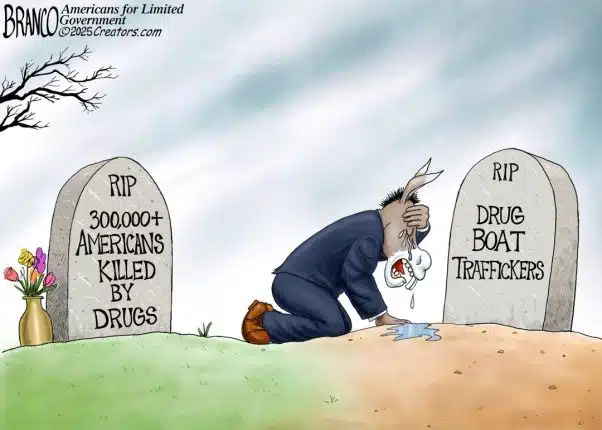Slightly more than four decades ago, the U.S. banned the use of the pesticide dichlorodiphenyltrichlororethane (thankfully, DDT, for short) which must certainly qualify as the most controversial synthetic chemical ever devised by humankind. There can be no doubt that DDT use has prevented deaths of many millions of the world’s most vulnerable residents from malaria and other insect-borne diseases. Nor can there be any real question that long-term bans on its use in the most desperate nations have resulted in deaths of far many more. Publicity campaigns against its use premised upon toxicity to wildlife and humans, whether true or not, have been enormously effective.
While many of the arguments against DDT are based upon dubious quasi-scientific claims, there are also studies that raise certain legitimate concerns warranting further investigation. Accordingly, a great need exists for truly objective research which avoids persistent political and ideological influences. In addition to comprehensive analyses of human and bio-system risks, benefits and necessary controls, consequences of delayed interventions must also be assessed. The more than 30,000 annual cases of avoidable Lyme disease in the U.S. are but one example.
To better appreciate the past and present-day significance of this remarkable chemical compound, let’s flash back to a time soon after its properties were first “put into action” nearly seven decades ago. Robert Zubrin discusses this history in his excellent new book, Merchants of Despair.
The Other Secret Weapon of WWII
During the last days of WWII, the Nazis systematically destroyed aqueducts, reservoirs and the sewer system in Naples. Left without sanitation, the city of more than a million people was plagued with a lice-transmitted typhus epidemic which killed one out of four of the thousands who contracted it. Alarmed about the threat to our invading troops as well as the local population, General Eisenhower made a desperate plea to Washington for help.
Fortunately, a secret weapon called DDT was ready just in time. By January 1, 1944, the first shipments of what would eventually amount to 60 tons arrived in Italy. People lined up as military police officers dusted them with the powder while other spray teams dusted public buildings and shelters. By month’s end a miracle occurred…the lice were virtually exterminated and the epidemic was over.
As Allied forces advanced north from Naples to Rome, the retreating Germans then demolished dikes which Mussolini had constructed before the war to drain the mosquito-infested Pontine marsh — which made the area an uninhabitable malaria hellhole. The tactic temporarily served as an effective defense. Malaria struck 22,000 Allied troops during the early summer of 1943, a greater casualty toll than was inflicted by Axis forces directly.
But again, Americans turned their secret weapon DDT on the problem, deploying airborne crop dusters and infantry spray teams. Success was total. The Pontine mosquitos were wiped out, and GIs pushed on with negligible malaria losses to liberate Rome in the early morning of June 5. The Allied high command declared that from then forward, “DDT marches with the troops.”
As Winston Churchill stated on September 24, 1944: “We have discovered many preventives against tropical diseases, and often against the onslaughts of insects of all kinds, from lice to mosquitoes and back again. The excellent DDT powder which had been experimented with and found to yield astonishing results will henceforth be used on a great scale by the British forces in Burma and by the Americans and Australian forces in the Pacific and India in all theaters.”
And they did. Similar successes were achieved when British and American troops advanced in Europe and encountered, treated and saved lives of millions of victims of Nazi oppression who were dying from insect-borne diseases: civilians under occupation, slave laborers, prisoners of war, and concentration camp inmates. The DDT triumphs over diseases were realized in the Asia-Pacific theater: in the Philippines, Burma, China and elsewhere. Never before had a single chemical saved so many lives in so many places in such a short period.
In 1948, the Nobel Prize in Medicine was awarded to Paul Miller for discovering the chemical’s marvelous pesticide application. As the Nobel committee stated: “DDT has been used in large quantities in the evacuation of concentration camps, of prisoners and deportees. Without any doubt, the material has already preserved the life and health of hundreds of thousands.”
After WWII DDT became widely available to public health agencies around the world, very much including the U.S. Prior to the war between one and six million Americans, mostly drawn from rural regions of the South, contracted malaria annually. In 1946 the U.S. Public Health Service initiated programs to apply DDT to interior walls of homes, and by the first half of 1952, there were only two confirmed malaria cases in the entire nation!
Thanks to DDT, comparable results were being realized in other countries: Malaria virtually disappeared in Europe by the mid-1950s; rates rapidly dropped by 80 percent in South Africa; Ceylon (now Sri Lanka) saw a malaria incidence drop from 2.8 million in 1946 to 17 total cases in 1963; and similarly, India cut its malaria death rate to nearly zero.
In 1955, with U.S. financial backing the UN World Health Organization (WHO) launched a global DDT campaign to eradicate malaria across large areas of the developing world which cut rates in Latin America and Asia by 99 percent or better.
A New War: DDT Becomes the Enemy
Not everyone, however, was happy about all of these achievements. One such person was Club of Rome co-founder Alexander King. In 1990 he expressed why: “My own doubts came when DDT was introduced for civilian use. In Guyana, within two years it had almost eliminated malaria, but at the same time the birth rate doubled. So my chief quarrel with DDT in hindsight is that it greatly added to the population problem.”
Powerful counter-forces against the use of DDT can be traced to the birth of a new “environmental movement”. An early salvo of the attack on DDT came from Aldous Huxley, who became famous for his 1932 book, Brave New World. Huxley’s subsequent Brave New World Revisited (1958) warns that the danger to civilization posed by Third World overpopulation would lead to communist revolution, attacking DDT as an important contributor: “We go to a tropical island…and with the aid of DDT we stamp out malaria, and in two or three years, save hundreds of thousands of lives.”
Huxley continued that: “This is obviously good, But the hundreds of thousands of human beings thus saved, and the millions whom they beget and bring to birth, cannot be adequately clothed, housed, educated or fed out of the island’s available resources. Quick death by malaria has been abolished; but life made miserable by undernourishment and over-crowding is now the rule, and death by outright starvation threatens ever greater numbers.”
Five years after Huxley’s Brave New World Revisited was published, a more direct broadside hit on DDT in the form of a blockbuster book by marine biologist and nature writer Rachael Carson would prove to have devastating public impact. Silent Spring presented a poignant, fictional story about a town whose people had been poisoned, and whose spring had been silenced of birdsong, because all life had been exterminated by pesticides. Many credit her book not only for subsequent global bans against DDT, but also for energizing anti-industry/anti-capitalist Malthusian socialist activism of incalculably huge influence.
Central to Carson’s story is a claim that DDT threatened many avian species with imminent extinction due to thinning eggshells. Some of the research cited in her book to support that conclusion appears to be faulty since the original studies were performed on captive chickens fed a lab diet with insufficient calcium to support normal egg shell development. In fact, as Zubrin notes, during a period of widespread DDT spraying preceding Silent Spring bird populations had increased significantly…quite possibly influenced by suppression of avian parasites.
Having said this, more recent research does add some credence to Carson’s hypothesis. A 2009 study conducted on domestic hens suggests that exposures of higher doses of DDT than are reported in wild birds, acting as a synthetic estrogen, can cause egg thinning and reduced egg production.
The research also theorizes that wild birds are exposed to other estrogen contaminates that might act “additively”. Since abnormally high laboratory doses of a great many natural and synthetic substances can and do have a variety of deleterious health effects, questions remain regarding what pesticide application dose levels are permissible, how they can be controlled, and other natural and synthetic estrogens to be taken into account in determining application-specific safeguards.
Carson’s book also claimed that synthetic insecticides can affect the human body in “sinister and often deadly ways,” asserting that cumulatively, the “threat of chronic poisoning and degenerative changes of the liver and other organs is very real.” She also reported that one expert specifically rated DDT as a “chemical carcinogen.”
Yet numerous World Health Organization studies have indicated that workers with intense exposures to DDT as much as thousands of times more than an average dose have failed to show “any convincing evidence of patterns of associations between DDT and cancer incidence or mortality.” Such studies involving thousands of people have investigated many different cancers, including breast cancer, lung cancer, testicular cancer, prostate cancer and others over many decades.
There was, however, a later study suggesting that DDT exposure prior to puberty might be linked to increased breast cancer risk later in life. In October 2007 the Environmental Research Foundation (EMF) reported that University of California-Berkeley research based upon 129 Bay Area women born between 1945 and 1965 when DDT was being sprayed in the U.S. to control mosquitos and other insects later developed breast cancer at five times the rate of those born earlier.
As reported by EMF, several earlier much larger studies found no such evidence that DDT caused breast cancer. The largest, in 2002 involving 3,000 Long Island, N.Y., women concluded that the breast cancer rate did not rise with increased blood DDT levels.
Referring to the Berkeley study, Steven Stellman, a professor of clinical epidemiology at Columbia University, commented at the time that a five-fold increased breast cancer risk is considered very high, but admitted that because relatively few women were involved, the study was prone to statistical weakness, which might mean the result is partly attributable to chance. Other known risk factors include alcohol consumption, hormone therapy and age of menstruation.
Political Science and Its Deadly Consequences
Summarizing all relevant research up to 2002, the U.S. Government Agency for Toxic Substances and Registry (ATSDR) reported that “there is no clear evidence that exposure to DDT/DDE causes cancer in humans.” Still, responding to public panic and political pressure aroused in good measure by Carson’s book, governments of several developing countries ended their DDT-based anti-malaria programs. Her claims are also clearly credited with a prohibition against DDT use in the U.S. since 1972, and a similar ban in Europe.
These widespread actions to prohibit DDT use occurred after the U.S. National Academy of Sciences issued a 1970 report stated: “To only a few chemicals does man owe as great a debt as to DDT. It has contributed to the great increase in agricultural productivity, while sparing countless humanity from a host of diseases, most notably, perhaps, scrub typhus, and malaria. Indeed, it is estimated that, in little more than two decades, DDT has prevented 500 million deaths due to malaria that would otherwise have been inevitable.”
NAS also concluded: “Abandonment of this valuable insecticide should be undertaken only at such time and in such places as it is evident that prospective gain to humanity exceeds the consequent losses. At this writing, all available substitutes for DDT are both more expensive per crop-year and decidedly more hazardous.”
Disregarding the NAS, the U.S. DDT prohibition was issued in a decision by then newly formed EPA administrator William Ruckelshaus following a seven month-long hearing on risks and benefits of the material in 1971. But after calling 125 witnesses and reviewing 9,362 pages of testimony, Judge Edmund Sweeney, the appointed hearing examiner, had actually concluded that alarm was unwarranted: 1) “DDT is not a carcinogenic hazard to man”; 2) “DDT is not a mutagenic or teratogenic hazard to man”; and 3) “The use of DDT under the registrations involved does not have a deleterious effect on fish, estuarine organisms, wild birds, or other wildlife.”
Reportedly, Ruckelshaus had never attended a single hour of the hearings, and according to his chief of staff, didn’t even bother to read Judge Sweeney’s report.
The World Health Organization had pleaded at the EPA hearings that DDT was very beneficial in fighting malaria in many parts of the world and should not be banned, stating that withdrawal of its use would be “…a major tragedy in the chapter of human health.”
Still, due to threatened European trade restrictions against countries that used the chemical, African nations terminated use of the effective mosquito pesticide for malaria control with catastrophic results. In Ceylon, for example, where the chemical’s use had cut malaria cases from millions each year to only 17 by 1963, a resurgence following the ban raised the infection rate back to half a million victims by 1969.
Yes, As a Last Resort…Some New Science Please
World views about use of insecticides in general and DDT in particular have finally become more receptive in recent years. In 2006, nearly thirty years after phasing out widespread use of indoor spraying with DDT and other insecticides (with limited exceptions), WHO, UNICEF, and USAID finally approved it as a measure of last resort. This has reversed policies established in 2004 by a Stockholm Convention which legally bound most UN-participant nations to “take actions to reduce or eliminate the production, use and/or release” of DDT.
WHO, which had previously promoted indoor spraying until anti-DDT protests won final influence in the early 1980s, has now re-instituted the practice in epidemic malaria regions and areas with constant and high transmission including throughout Africa. The Environmental Defense Fund, which originally launched a large anti-DDT campaign in the 1960s along with the Sierra Club and the Endangered Wildlife Trust, has joined WHO to endorse DDT spraying on inside walls of households in countries where malaria epidemics exist.
The President George W. Bush administration earmarked $1.2 billion to a program aimed at cutting malaria deaths in half through efforts which included indoor DDT spraying. As program coordinator Admiral R. Timothy Ziemer explained, “Because it is relatively inexpensive and very effective, USAID supports the spraying of homes with insecticides as part of a balanced, comprehensive malaria prevention and treatment program.” Thanks in large part to U.S. support, India has witnessed a dramatic reduction in malaria cases and fatalities. At least 14 countries in sub-Saharan Africa are conducting indoor spraying with long-lasting insecticides, with DDT the most popular.
Tragically, earlier interventions would very likely have avoided countless millions of unnecessary deaths. The vast majority of these past and current victims are black and desperately poor, including large numbers of young children and elderly who are especially vulnerable.
As Dr. Arata Kochi, Director of WHO’s global Malaria Programme, said: “We must take a position based on the science and the data. One of our best tools we have against malaria is indoor residual house spraying. Of the dozen insecticides WHO has approved as safe for house spraying, the most effective is DDT.”
And what about here in America? Should those pesky mosquitoes and more than 30,000 annual cases of Lyme disease be tolerated if they are avoidable through selective and carefully monitored indoor and outdoor spraying of high infestation locations? Under what conditions might that be a safe thing to do? And if serious, responsible, unbiased research is required to make those decisions, shouldn’t we all be itching to have that begin?
Special Credits and References for this Article:
I wish to specially thank Dr. Steven Hatfill, a physician and medical researcher with very extensive experience addressing malaria and other tropical diseases for his valuable advice in preparing an article on this controversial and complex topic. Additional reference articles and reports worthy of note include the following;
Cohn, BA; Cohn BA, Wolff MS, Cirillo PM, Sholtz RI (October 2007). “DDT and breast cancer in young women: new data on the significance of age at exposure”. Environ. Health Perspect. 115 (10):
Chen A, Rogan WJ (2003). “Nonmalarial infant deaths and DDT use for malaria control”. Emerging Infect. Dis. 9 (8): 960–4.
Sagiv SK, Nugent JK, Brazelton TB, et al. (May 2008). “Prenatal organochlorine exposure and measures of behavior in infancy using the Neonatal Behavioral Assessment Scale (NBAS)”. Environ. Health Perspect. 116 (5): 666–73
Ribas-Fitó N, Torrent M, Carrizo D (2006). “In utero exposure to background concentrations of DDT and cognitive functioning among preschoolers”. Am. J. Epidemiol. 164 (10): 955–62.
Torres-Sánchez L, Rothenberg SJ, Schnaas L (2007). “In utero p, p’-DDE exposure and infant neurodevelopment: a perinatal cohort in Mexico”. Environ. Health Perspect. 115 (3): 435–9..
Nagayama J, Kohno H, Kunisue T (2007). “Concentrations of organochlorine pollutants in mothers who gave birth to neonates with congenital hypothyroidism”. Chemosphere 68 (5): 972–6.
Van Wendel de Joode B, Wesseling C, Kromhout H, Monge P, Garcia M, Mergler D (2001). “Chronic nervous-system effects of long-term occupational exposure to DDT”. Lancet 357 (9261): 1014–6.
“Environmental and occupational causes of cancer: new evidence 2005–2007″. Rev Environ Health 23 (1): 1–37
Committee for a Constructive Tomorrow Advisor Larry Bell heads the graduate program in space architecture at the University of Houston.







